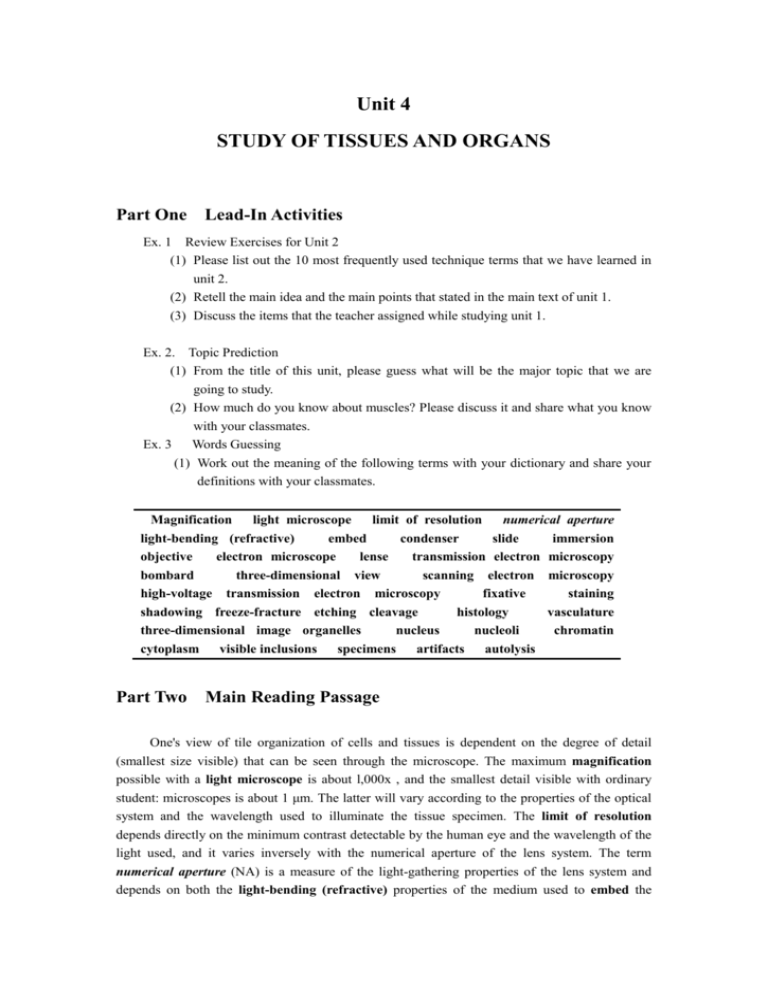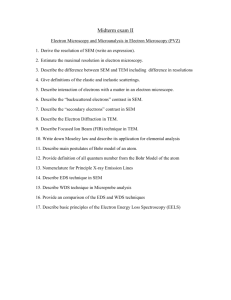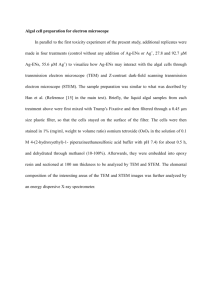study of tissues and organs
advertisement

Unit 4 STUDY OF TISSUES AND ORGANS Part One Lead-In Activities Ex. 1 Review Exercises for Unit 2 (1) Please list out the 10 most frequently used technique terms that we have learned in unit 2. (2) Retell the main idea and the main points that stated in the main text of unit 1. (3) Discuss the items that the teacher assigned while studying unit 1. Ex. 2. Topic Prediction (1) From the title of this unit, please guess what will be the major topic that we are going to study. (2) How much do you know about muscles? Please discuss it and share what you know with your classmates. Ex. 3 Words Guessing (1) Work out the meaning of the following terms with your dictionary and share your definitions with your classmates. Magnification light microscope limit of resolution numerical aperture light-bending (refractive) embed condenser slide immersion objective electron microscope lense transmission electron microscopy bombard three-dimensional view scanning electron microscopy high-voltage transmission electron microscopy fixative staining shadowing freeze-fracture etching cleavage histology vasculature three-dimensional image organelles nucleus nucleoli chromatin cytoplasm visible inclusions specimens artifacts autolysis Part Two Main Reading Passage One's view of tile organization of cells and tissues is dependent on the degree of detail (smallest size visible) that can be seen through the microscope. The maximum magnification possible with a light microscope is about l,000x , and the smallest detail visible with ordinary student: microscopes is about 1 μm. The latter will vary according to the properties of the optical system and the wavelength used to illuminate the tissue specimen. The limit of resolution depends directly on the minimum contrast detectable by the human eye and the wavelength of the light used, and it varies inversely with the numerical aperture of the lens system. The term numerical aperture (NA) is a measure of the light-gathering properties of the lens system and depends on both the light-bending (refractive) properties of the medium used to embed the specimen and the angle at which light enters the field (controlled by the condenser). It follows, then, that the resolution of the field will depend on how well the slide was prepared and how well the microscope is adjusted, as well as on several other considerations. The best theoretical numerical aperture obtainable with the light microscope is 1.4xfor oil immersion and 1.Ox for high dry (40X objective). This limits resolution to a theoretical maximum of about 0.2 μm using short wavelength (blue) light. The electron microscope employs beams of electrons having properties much like light but of ultrashort wavelength. However, since the electrons in the short wavelengths of the beam can be captured by air particles in their path, the beam and the specimen must be placed in a vacuum. The electron beam is focused by magnets that serve the same function as lenses in an optical system using visible light. The first electron microscope designs required that electrons pass through the specimen to generate an image. This technique is called transmission electron microscopy. Within the past few years, two new techniques have been developed in which whole specimens or thick sections rather than thin sections can be bombarded with an electron beam and a three-dimensional view of the tissue surface obtained by detecting the patterns of scattered electrons. These techniques are called scanning electron microscopy and high-voltage transmission electron microscopy. Contrast in electron microscopy is obtained by treating the tissue with heavy metals that impede the passage of electrons (that is) electron-dense chemicals) or by forming precipitates that are electron dense using antigen-antibody reactions. A new field has arisen in which tissue compounds can be identified in this manner (immunocytochemistry). Heavy metal salts such as osmium are often used as combined fixative and "staining" agents. Osmium is taken up to a different degree by the various cellular components. To heighten contrast, other heavy metal salts of lead and uranium are applied to thin sections after they are cut. This process is called shadowing and can be employed to show the contours of cellular elements. A commonly used technique is freeze-fracture etching. In this technique a tissue is frozen quickly in liquid nitrogen and then shattered along natural lines of cleavage in the tissue. The surface is then etched with metals and an image obtained of the surface texture. Freeze-fracture etching permits visualization of the location of proteins within membranes, for example. Fig. 1-1 gives an idea of the sizes of objects normally studied in anatomy. The usual range encountered in histology varies from the limit of resolution of most student microscopes (1.0 μm) to the limit of resolution of the unaided human eye (0.1 mm or 100μm). Cells range in size from 8 μm (red blood cells) to 150 μm (ripe ova). The size utmost cell falls between these two values. For approximating cell size in a tissue .section, the red blood cell is a useful standard. It measures approximately 8 nm in diameter and is usually present in the vasculature of most tissue. However, it must be remembered that processing tissues almost always causes some variation in the cell size. One of the main objectives should be to develop an ability to visualize and construct a three-dimensional image of the cell or tissue from the flat, roughly two-dimensional object found on the microscope slide. To demonstrate how an object can apparently change in shape depending on bow it is cut, one should consider the appearance of a simple spherical object such as an orange that has been cut in several planes (Fig. 1-2). The segments of the orange vary in shape depending on the plane of the section. The same kinds of variation will arise in connection with the study of cell and tissue structure. Cellular detail visible with the light microscope is somewhat limited even when special stains are used, since most organelles are smaller than the resolution of the light microscope. For this reason it is essential to learn to recognize cells and tissues on the basis of several simple criteria. For example, one clue useful in identifying cell types is the appearance of the nucleus. In examining a slide of loose connective tissue (Fig. 3-7, for example), one can readily observe that the nuclei differ from each other in size, shape, staining intensity, presence or absence of nucleoli, degree of clumping of chromatin, and distinctness of the nuclear envelope (visible at the light microscope level only because of a rim of chromatin attached to it). Usually little if any cytoplasm is visible, and in addition the boundaries between cells may be indistinct. When cytoplasm is visible, the presence of variations in its staining properties (regions of basophilia, for instance) or the presence of visible inclusions (glycogen, pigment granules, vacuoles left by dissolved fats) should be noted. The identification of cells or tissues on the basis of color alone is not feasible because of the diverse coloration that stained specimens may exhibit. Another aspect of prepared specimens used in the study of histology both clinically and experimentally is the presence of artifacts. Poor tissue preservation or too long a delay before fixation results in autolysis (self-digestion) of the tissue and disruption and shrinkage or swelling of the cells. As slides age, the stain fades, reducing color contrast. Such distortions in the appearance of normal tissues may be present in the slides available for study. (1042)








